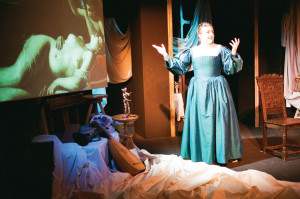Artemisia, Light and Shadow
ARTEK, New York City’s premiere early music ensemble, presents
Artemisia, Light and Shadow
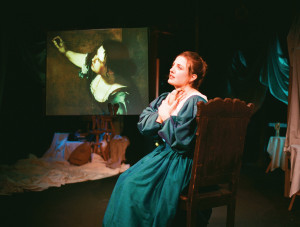
A newly-conceived one-woman multi-media show on the life of 17th-century painter and feminist heroine Artemisia Gentileschi
A life more dramatic than an Italian opera: Trained in art by her father, raped as a teenager, Artemisia survived a sensational trial to become an internationally renowned painter, and the secret lover of a Florentine nobleman.
After an extended run in downtown Manhattan, ARTEMISIA: LIGHT AND SHADOW has been touring art galleries and college campuses. Just over an hour long, it is appropriate for departments of Women’s Studies, Art, and Music. Performances are fully costumed, enhanced with images of her paintings (now in the Metropolitan, the Tate, and other famous museums) and sung arias of Artemisia’s time by baroque composers Barbara Strozzi and Francesco Cavalli, with harpsichord accompaniment. Performances are possible in black box theaters, full-size theaters, or concert halls. ARTEK director Gwendolyn Toth is available for Q & A with audiences following the the show, as well as liaising for classroom pre-show preparation.
To discuss a performance on your campus, contact the director of ARTEK, Gwendolyn Toth, at artekearlymusic@gmail.com.
From the playwright
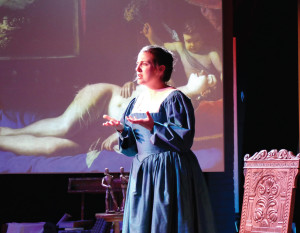
Four hundred years after she and her work dazzled European nobility from the Medicis to Charles I of England, Artemisia Gentileschi is remembered not only for her paintings – subject of a major show at the Met just sixteen years ago – but for the dramatic events of her life. Indeed, letters discovered as recently as 2011, added to documents that survive from her youth in Rome and adulthood in Florence and other Italian cities, have expanded our vision of her from a fascinating figure in art history to a passionate woman of enormous strength and charm.
Artemisia Gentileschi was born in Rome in 1593. Her father Orazio Gentileschi was a well-known painter, a follower of Caravaggio. Artemisia trained in her father’s studio and by her teens was already attracting notice, most famously for a painting of Susanna and the Elders. At eighteen, she was raped by a painter named Agostino Tassi and, although he was brought to trial and found guilty, the disgrace caused her to marry Pierantonio Stiattesi in 1612 and leave with him for Florence. There she flourished at the brilliant court of Duke Cosimo II de Medici, becoming the first woman invited to join the Accademia del Desegno. However, in 1619, debt and probably scandal (her letters to a lover have recently surfaced) forced her to return to Rome with her husband and children. By middle age she was alone – a letter survives in which she asks a friend (in a postscript) whether her husband is alive or dead – but more successful than ever. She lived in Venice for a while but spent her last decades in Naples where, according to one contemporary account, a visitor needed only to ask for the home of the female painter; every passerby knew whom he meant and could direct him.
Some biographical details remain controversial, such as how many children she had and exactly when and how she died. Similarly, the attribution of a number of paintings remains controversial: whether or not she painted them, and whether or not she herself is the model. In this show, Artemisia’s letters to Francesco and to patrons are primarily direct quotations from the originals, as are the excerpts from trial testimony and the sonnets written in her honor by contemporaries.
– Nahma Sandrow
Literary sources consulted include Mary D. Garrard: Artemisia Gentileschi, The Image of the Female Hero in Italian Baroque Art (1989); Jesse M. Locker: Artemisia Gentileschi, The Language of Painting (2015); Eva Menzio: Atti di un Processo per Stupro (1981) Francesco Solinas: Lettere di Artemisia (2011); Eve Straussman-Pflanzer: Violence and Virtue, Artemisia Gentileschi’s “Judith Slaying Holofernes” (2013)
A mini-opera for today
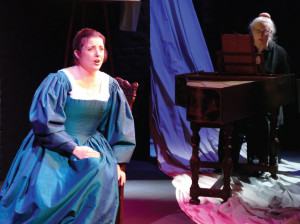
As the director of a historical performance ensemble, I am often confronted with the question: “How is something from 400 years ago relevant to today’s audiences?” The simple answer is that music is about communication and relationships between people; the people of 400 years ago felt the same emotions that we do today.
A woman confronting the difficulties of making a living as an artist, of negotiating a complicated love affair, of dealing with the aftermath of rape and violence – a story straight out of today’s New York Times. 400 years have made no difference. We feel Artemisia’s pain, longing, and joy as one of us.
Especially in the light of the MeToo movement – not to mention, corporate glass ceilings, wage inequity, lack of daycare, access to birth control, etc. – her story has relevance for every woman (and man) in audiences today. Many women of my generation grew up thinking that the feminism of the 1960s had changed society and we were largely beyond the institutionalized oppression of women. The events of our own time and the events of the past in this “opera” make us think about how far we haven’t yet come.
We chose to include some spoken dialogue, rather than set every word in music as would be done in a true opera. Perhaps this really is an early music version of musical theater. We also chose to include only the voice of Artemisia (although we hear other voices through her) in order to keep the focus on one of the most remarkable, exceptional women in history.
Her paintings alone are an enormous legacy to us. But the documents that chronicle her life are also an amazing testament. The fact that her love letters to Francesco were discovered only seven years ago makes me hope that more historical facts of remarkable women remain yet to be discovered, studied, and pondered.
Lastly, I chose much of the music from yet another trailblazing woman: female musician and early 17th century composer, Barbara Strozzi. She grew up in a musical household, had a flourishing career as a published composer, and was also a woman with a fascinating emotional life. I await with great anticipation the forthcoming book by Mary Garrard on both Artemisia Gentileschi and Barbara Strozzi, and I offer my heartfelt thanks to her for her inspiration to both Nahma Sandrow and me in the creation of this work.
– Gwendolyn Toth
The vocal music sung by Artemisia in the show is excerpted from the following sources:
Barbara Strozzi (1619-1677)
- From Cantate, ariette e duetti, op. 2 (1651): Grande Allegrezza (arranged Gwendolyn Toth)
- From Diporte di Euterpe ovvero Cantata e ariette a voca sola, op. 7 (1659): Lagrime; Pensaci ben mio core; Per un bacio
- From Arie a voce sola, op. 8 (1664): Cieli, stelle; Che si può fare
Francesco Cavalli (1602-1676)
- From the opera Artemisia (Venice, 1657): Ardo, sospire; and various recitatives arranged/rewritten by Gwendolyn Toth
Additional instrumental music is excerpted from works by Luzzasco Luzzaschi (c.1545-1607), Giovanni Gabrieli (c.1554/1557-1612) intabulated by Bernhard Schmid II (1535-1592), Cristofano Malvezzi (1547-1599) intabulated by Schmid, and Giovanni Girolamo Kapsberger (c.1580-1651).
Reviews
ART
“I have seen Artemisia: Light and Shadow twice and would gladly see it again. It is a touching drama Artemisia Gentileschi, and of her fascinating late Renaissance era in Italy. Beyond being rich in history, music, and art, this is a living portrait of a complex and wonderful person told primarily in her own words. Artemisia is almost as much “at home” in our time, in this production, as she was in her own time. Both the many difficulties she managed and her will to exercise her talents across her successful art career come alive for us.”
Richard Barnet, Associate Professor of Fine Arts: College of Mount Saint Vincent (Riverdale, NY) 9/23/18
MUSIC
“I very much enjoyed the show. The script was wonderful, and the singing and delivery beautiful.”
Daniel Asia, Professor of Music, head of Composition Department: University of Artizona (Tucson, AZ) 5/19/18
WOMEN’S STUDIES
“I was first able to attend the most enchanting opera/play: ARTEMISIA: LIGHT AND SHADOW, written by Nahma Sandrow, composed by Gwendolyn Toth (of ARTEK); directed by Paul Peers, who designed the set; lighting was by Chenault Spence, costumes by Carol Sherry. The music was utterly amazing. Gwendolyn Toth played the lute-harpsichord and Daniel Swendeberg, played the stringed theorbo. The composer excerpted arias written by 17th-century composers Barbara Strozzi and Francesco Cavalli.
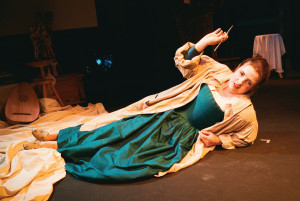
And there she sat—Artemisia Genileschi herself, wonderfully acted and sung by soprano Sarah Chalfy; we first meet her as she sits on a chair with her back to the audience. This gives us time to take in the set, which is composed of gracefully draped cream-white drop cloths that one might find in a great artist’s studio, and two canvas-like screens. On one, the words sung in Italian are translated into English, on the other—oh, how exquisite, Artemisia shows us her magnificent paintings, miracles of “light and shadow.” There’s her Susanna and the Elders, her (many) Judith’s slaying Holofernes, her many self-portraits, her strong, Biblical figures: all lush, grand, detailed. Like Michelangelo, Artemisia pleads for her wages, confides in us that royalty do not always pay their bills and that she has learned she must demand payment in advance.
Artemisia is, by turns, witty, joyful, tragic, woebegone, tragic, (she lost three children, she was, famously, raped at 18, and after many splendid years in Florence under the protection of Duke Cosimo II Medici, she was exiled back to Rome and then Naples where she weathered scandal, solitude, and poverty). On stage, Artemisia is also vengeful, but philosophical, and ultimately joyful. She sings of fate and destiny and, as she did so, I was moved, included, inspired, comforted. For those who live in New York: There are two more performances: One on Saturday, May 19th at 7:30pm, on Sunday, May 20th, at 4pm and the last one on Sunday May 20 at 7:30pm. It’s at the Flea Theater (20 Thomas Street), a sparkling new, small jewel of a theater, very London-like, and located in Tribeca.”
Phyllis Chesler, author of Women and Madness and A Politically Incorrect Feminist, Emerita Professor of Psychology and Women’s Studies: City University of New York. Posted in: Phyllis Chesler Organization, www.phyllis-chesler.com: Arts, Film & Culture, Global Culture 5/18/18
LIFE
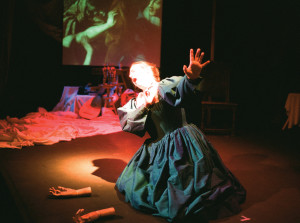
“In the last fifty years, Artemisia Gentileschi has risen to new eminence. She originally gained fame among her seventeenth-century contemporaries as a talented Baroque painter in the manner of Caravaggio. Her remarkable works failed to garner much attention in the three centuries that followed. Since the 1960s, however, Artemisia has been unmissable. Exhibitions, catalogs, and scholarly studies of her several dozen surviving paintings have poured forth, along with biographies, letters, novels, a TV mini-series, and plays. Artemisia even has a place setting at Judy Chicago’s vagina-themed installation Dinner Party (1974–79)—suggesting that some of the hurrahs for Artemisia arise more from her perceived usefulness to feminism than from an interest in her beautiful and often disturbing art.
Artemisia: Light and Shadow, a one-act, one-person play at the Flea Theater in Tribeca (May 15–20), is a welcome exception. In a tranquil monologue scripted by Nahma Sandrow, Artemisia (Sarah Chalfy) reflects on the triumphs, agitations, and agonies of her life and career. The agonies were severe. Artemisia was raped at eighteen by the painter Agostino Tassi, whom her father had hired to improve her mastery of perspective. Her father brought charges, and in the ensuing trial the judge ordered Artemisia put to torture to determine whether she was telling the truth. Tassi was convicted, but at the cost of further injury to Artemisia—who now additionally bore a ruined reputation.
It is easy, perhaps too easy, to connect Artemisia’s paintings of biblical heroines with this terrible experience. Her images of Judith beheading Holofernes are among the most horrific in the Western canon. She also painted Salome with the Head of Saint John the Baptist, and Jael driving a spike through the head of Sisera. The women are calm, deliberate killers. Holofernes and Sisera get no pity.
But Sandrow refrains from turning Artemisia’s life and art into a #MeToo parable. This Artemisia is an artist filled with joy at the sumptuous beauty she creates and the radiant colors that escape from the shadows. She knows her worth as an artist and demands that her patrons pay full price. At a crucial juncture, she sheds what little self-pity she has and steps fully into her own life. When eventually she speaks to the audience of her suffering, she does so with reluctance. It is as though her anger had been dispelled in the making of those exquisite paintings.
Adding variety to the monologue are period arias sung by Chalfy, who has numerous opera and musical theatre credits. She is accompanied on harpsichord, theorbo, and lute. Chalfy’s rich soprano gives voice to the passion her character cannot express in her spoken words. A marriage of convenience, the deaths of several of her children, and one passionate love affair make up the signal events of Artemisia’s personal life, together with her constant shifts from city to city and court to court in search of patronage. A screen stage-left intermittently displays Artemisia’s paintings, occasionally homing in on the fine details of her brushwork.
Chalfy brings a touch of wryness to her role. Her Artemisia is ironic and confident, ready to puncture the puffery of the world, sparing not even herself. The challenges she faced as a woman in what was then a man’s occupation are not of the essence of her story. Her self-possession is. Artemisia possesses bravery, endurance, intelligence, a rich visual imagination, technical skills of the highest caliber, and practical cunning sufficient to cut deals with the Medici. But she also knows herself. Toward the end of the play, we see in succession some of the costumed self-portraits Artemisia painted into her compositions. None are especially flattering, but all present a woman who is equal to the occasion.”
Sandrow’s play and Chalfy’s performance are a welcome restoration of an important artist who has recently suffered more from adulation than from detraction. Chiaroscuro, the bold contrast of light and shade, is the most evocative technique in Artemisia’s painting. This play makes real both the bright patches and the dark, in art as in life.”
Peter Wood: President, National Associationof Scholars. Posted in First Things 5/25/18
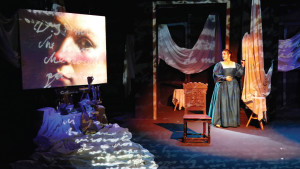
About the Company
ARTEK concerts are renowned for exciting, dramatic performances of baroque music. Founded by director Gwendolyn Toth in 1986, ARTEK features America’s finest singers and instrumentalists. Highlights of ARTEK’s past seasons include acclaimed performances of ARTEK’s theater show I’ll Never See the Stars Again at the Edinburgh Fringe Festival; standing ovation performances at the Regensburg (Germany) Tage Alter Musik Festival; and the Boston, Berkeley, Bloomington and Indianapolis early music festivals in the US. ARTEK toured internationally from 1997 to 2002 with the Mark Morris Dance Group, visiting major venues in the United Kingdom, Italy, and Canada as well as more than fifty of America’s premier theaters. In the New York City area, ARTEK has appeared at Lincoln Center; Wall-to-Wall Opera at Symphony Space; Metropolitan Museum; Music Before 1800; Peak Performances in Montclair and Princeton Friends of Music series. ARTEK’s recordings of Monteverdi’s opera Orfeo, Madrigals Book 5, and other early Italian repertoire have been widely praised. ARTEK’s latest recording is Soli Deo Gloria, featuring solo cantatas of Johann Rosenmüller. The ensemble’s latest recording project is the complete Monteverdi: Madrigals, Book 7. www.artekearlymusic.org
Sarah Chalfy, soprano, is an active performer on a variety of musical stages, from Off-Broadway theatres to concert halls to cabaret and rock venues like Lincoln Center, Carnegie Hall, the Knitting Factory, Galapagos, Don’t Tell Mama, and beyond. With ARTEK, she has performed in I’ll Never See the Stars Again, Selva Morale of 1640, and Book IV Madrigals, all by Monteverdi. A specialist in premiering new works, she created the title role in Kim D. Sherman’s opera ADA. The prior season, Ms. Chalfy created the role of Nellie Bly in David Friedman/Peter Kellogg’s new musical Stunt Girl. She performed the role of Madeleine X in the LA world premiere of Michael Gordon’s opera What to Wear, conceived, designed, and directed by avant garde theatre legend Richard Foreman. She has collaborated with some of NYC’s hottest new music ensembles, including Alarm Will Sound, Newspeak, and NOW. She also performed Gordon’s chamber opera Van Gogh, which she recorded on the Cantaloupe label with Alarm Will Sound. Opera and musical theater credits include Helena (A Midsummer Night’s Dream), Gretel (Hansel and Gretel), Adele (Die Fledermaus), Anne Sexton (Transformations), Vixen (The Cunning Little Vixen), Yum Yum (The Mikado), Guenevere (Camelot), Marian (The Music Man), Carrie (Carousel), and Hodel (Fiddler on the Roof). Ms. Chalfy was a fellow at the Tanglewood Music Center, where she was soloist in Berio’s Sinfonia with Robert Spano and Vivaldi’s Gloria with Craig Smith and the Mark Morris Dance Group. She is the recipient of numerous awards,
including top prizes in the Lotte Lenya, Rosa Ponselle, Canticum Dominum, and Bach Society of Baltimore competitions, and study grants to the Universität Mozarteum Salzburg and the Académie Internationale d’Été de Nice.
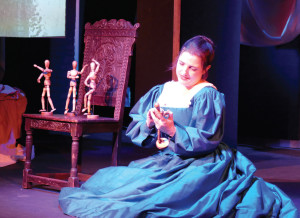
Recognized not only as one of America’s leading performers on early keyboard instruments but also as a respected conductor and music director, Gwendolyn Toth has conducted at Sadler’s Wells Theater in London for the Mark Morris Dance Group; at Skylight Theater in Milwaukee with Stephen Wadsworth; at Brooklyn Academy of Music in New York City with Rhys Chatham; for German Radio with the SEM Ensemble; and at Astoria Music Festival in Oregon. Recent highlights include conducting Bach’s B minor Mass with the Washington Bach Consort and serving as Music Director of the Virgina Best Adams Vocal Master Class at the Carmel Bach Festival in 2017.
Nahma Sandrow’s Vagabond Stars: A World History of Yiddish Theater is now in its third edition and remains the definitive work in the field. Her other books include God, Man, and Devil: Yiddish Plays in Translation and Surrealism: Theater, Arts, Ideas. In addition, she has written feature articles for the New York Times, the New York Sun, ARTnews, and other newspapers, magazines and journals. The opera Enemies, A Love Story (based on I.B. Singer’s novel), for which she wrote the libretto with composer Ben Moore, had its world premiere at the Palm Beach Opera in February, 2015. Ms. Sandrow won the Outer Critics Circle Award for the book of the musical Kuni-Leml. Other theater credits include the adaptation of her prize-winning history Vagabond Stars for the stage, and many translations, several of which have been produced. She is the recipient of grants from the National Endowment for the Humanities, the National Endowment for the Arts, and the Research Foundations of both the State University of New York and the City University of New York. A PEN-nominated grant from the New York State Council on the Arts supported her translation of Shulamis, a classic Yiddish operetta, which was subsequently performed at Harvard University. Ms. Sandrow lectures widely. She has spoken at universities such as Harvard and Oxford, as well as at the Smithsonian Institution and many other academic and cultural organizations. She is a graduate of Bryn Mawr College and the Yale School of Drama.
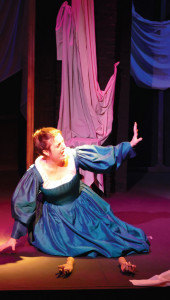
Paul Peers is a stage director whose work spans theatre, musical-theatre and opera. He just completed a residency at the HERE Arts Center, New York where he created and developed in collaboration with composer Matt Marks a new opera-theatre piece about the courtesan-spy Mata Hari, culminating in a world premiere production for New York’s premiere opera-theatre/music-theatre festival Prototype in January 2017. His opera directing debut was Händel’s Xerxes for Grammy nominated Boston Baroque. He directed Mozart’s La Finta Giardiniera at the Alexander Kasser Theater, New Jersey and was invited back again to Boston Baroque to direct Händel’s rarely performed Amadigi di Gaula. Mr. Peers’ international directing credits are: Australia – David Mamet’s Glengarry Glen Ross for the Adelaide Fringe Festival, Shakespeare’s King Lear for Lightning Strike Theatre Company, Peter Weiss’ Marat/Sade, Menken and Ashman’s Little Shop of Horrors for Adelaide College of Arts; Canada – Giuseppe Verdi’s Don Carlo and Amon Miyamoto’s production of Tan Dun’s Tea: A Mirror of Soul for Vancouver Opera; Germany – Geöffnet for the Dosto Projekt in Berlin. His New York Off-Off Broadway credits are: Libby Leonard’s Blue Balloon for Columbia University School of the Arts’ New Play Feast Festival at the 4th Street Theatre, Seneca’s Thyestes at the Theater of the Riverside Church, Love is in the Air at the 14th Street Y, Tennessee Williams’ Talk to me like the Rain and Let Me Listen at The Sanford Meisner Theater, Shadow Boxing by James Gaddas at The Theater for the New City and Poulenc’s La Voix Humaine at New York Theatre Lab. He is currently directing Jomelli’s opera Cerere Placata for Opera Lafayette in Washington, DC.
Chenault Spence is renowned throughout the world as lighting designer for ballet, opera and theatre, including the Alvin Ailey American Dance Theatre, with which he has been associated as a lighting designer for forty years and The Philadelphia Opera. With The Alvin America Dance Theatre he designed the ballets of Mr. Ailey and distinguished guest choreographers. As lighting designer for The Opera Company of Philadelphia, Mr. Spence received Emmy awards for The Damnation of Faust and Un Ballo in Maschera with Luciano Pavarotti. Mr. Spence is resident lighting designer for: The Ice Theatre of New York, New York Baroque Dance Company, Saeko Ichinohe Dance Company and The Long Leaf Opera Company. He has been designer for Lyon Opera Ballet, Dance Theater of Harlem, American Repertory Ballet, Juilliard Dance Ensemble, Erick Hawkins, Jose Limon, Bat-Dor Dance Company of Israel and The National Ballet of Iran. He has also served as the resident designer for Anchorage Alaska Opera and as guest designer for the Tetro Colon, Buenos Aires, Long Leaf Opera and Juilliard Opera Theatre. He designed the scenery and lighting for the world premiere in New York of No Easy Walk to Freedom (an opera based on the life of Nelson Mandela) and lighting for Blackwater (a multimedia opera production) at The Riverside Church in New York City. He has designed by invitation for New York City Ballet, American Ballet Theater, Houston Ballet, Royal Danish Ballet, Paris Opera Ballet, and many others. His theater designs include: the recent New York production of Roller Derby The Musical, If That Hat Could Talk, Only Heaven (off Broadway) as well as seasons of summer theatre, and cabaret.
Carol Sherry, costume designer, has worked on Flamingo Court at New World Stages, Fabuloso by John Kolvenbach and The George Place by David Johnston at Wellfleet Harbor Actors Theater, and The Bubble and Gemini the Musical for New York Musical Theater Festival. She also designs wigs and worked with Forbidden Broadway for eleven years. Previously, she designed ARTEK[‘s costumes for Monteverdi’s opera Orfeo and ARTEK’s show I’ll Never See the Stars Again.
